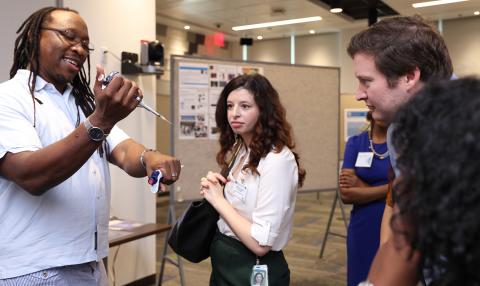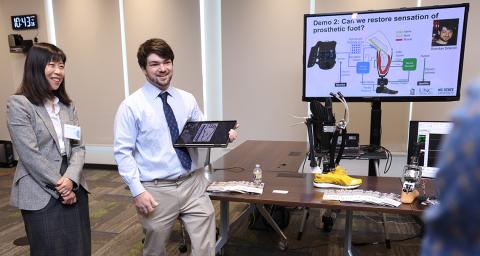NIBIB Welcomes Congressional Staff, Shows Pioneering Biotech

Photo: Chia-Chi Charlie Chang
After a years-long, pandemic-induced break, NIBIB welcomed congressional staff back to NIH to showcase cutting-edge technologies supported by the institute. Held June 27, the event was at the invitation of the American Institute for Medical and Biological Engineering (AIMBE), an advocacy group that brings together academia, industry, government and scientific societies to advance innovative, high-impact biomedical technologies.
NIBIB Director Dr. Bruce Tromberg began with an overview of the institute’s mission and key research areas with a special emphasis on Covid-19 pandemic technologies, spanning from over-the-counter diagnostic tests to artificial intelligence for medical imaging. Congressional staff then participated in five hands-on demonstrations given by NIBIB-supported grantees and intramural researchers.
One demonstration was given by NIBIB’s newest intramural investigator, Dr. Manu Platt. Platt is inaugural director of the Center for Biomedical Engineering Technology Acceleration (BETA Center), an NIH-wide resource designed to accelerate technology development to address urgent national and global health needs.
Platt also established the NIBIB laboratory for Mechanics And Tissue Remodeling Integrating Computational and Experimental Systems (MATRICES). During the event, he demonstrated a low-cost method to determine if HIV-positive individuals are taking their prescribed anti-viral medications, giving legislative aides the opportunity to try pipetting for themselves.

Photo: Chia-Chi Charlie Chang
Another demonstration was given by two groups from the Atlanta area.
The first group, led by Dr. Wilbur Lam and Erika Tyburski, presented a smartphone app that predicts anemia, a global health problem that affects more than 2 billion people. The app, which estimates hemoglobin levels by analyzing an image of the fingernail bed, is freely available on both iOS and Android devices and has been downloaded over 1 million times.
The second group, led by Lam and Julie Sullivan, gave an overview of the RADx Tech Test Validation Core, which independently assesses Covid-19 and other infectious disease diagnostic technologies prior to authorization by the Food and Drug Administration (FDA). Sullivan highlighted a variety of different tests that her group has validated and noted that the group is now working with NIBIB to evaluate the validity of multiplex tests, which can detect multiple viruses from a single sample.
A surgical robot, complete with a moving arm, was the focus of a demonstration by Dr. Axel Krieger and his team from Johns Hopkins University. Their experimental system, called STAR (for Smart Tissue Autonomous Robot), was developed to perform soft-tissue surgery, a procedure that represents unique challenges due to unpredictable tissue motions.

Photo: Chia-Chi Charlie Chang
In preclinical models of bowel surgery, STAR made fewer mistakes and had more consistent stitches compared with expert surgeons. This device could mitigate potential errors due to physician skill or fatigue, with a goal of making surgical procedures consistent and standardized for everyone.
Dr. He (Helen) Huang and her team from North Carolina State University and the University of North Carolina at Chapel Hill showcased a prosthetic device that seeks to help those with lower-limb amputations improve their balance and stability.
While many lower-limb prosthetics focus on ambulation, Huang’s research also aims to prevent falls among amputees. Her team’s device takes advantage of a user’s residual muscles and their associated electrical impulses to help control the prosthetic.
In addition to videos of their technology in action, the group brought lower-limb prosthetics and invited congressional staff to try out their sensor technology that provides haptic feedback to the user to improve balance.
The fifth demonstration was given by a group of researchers from FDA. They presented technologies that use tissue phantoms, which model human tissues, to aid in the regulatory assessment of medical devices.

Photo: Chia-Chi Charlie Chang
FDA has created a phantom library with more than 100 tools for medical device developers to use. The researchers presented phantoms that can be used in the retinal imaging space (using a human eye phantom), tissue phantoms for both cerebral and pulse oximetry (which can be affected by skin tone) and breast tissue phantoms for cancer detection.
“It was a pleasure to welcome back congressional staff to NIBIB to showcase how taxpayer dollars can facilitate the development of pioneering biotechnologies,” said Tromberg. “The research showcased here demonstrates how bioengineering and imaging research can improve health care across our country and around the world.”
For more information about NIBIB’s pandemic response, visit nibib.nih.gov/covid-19.
